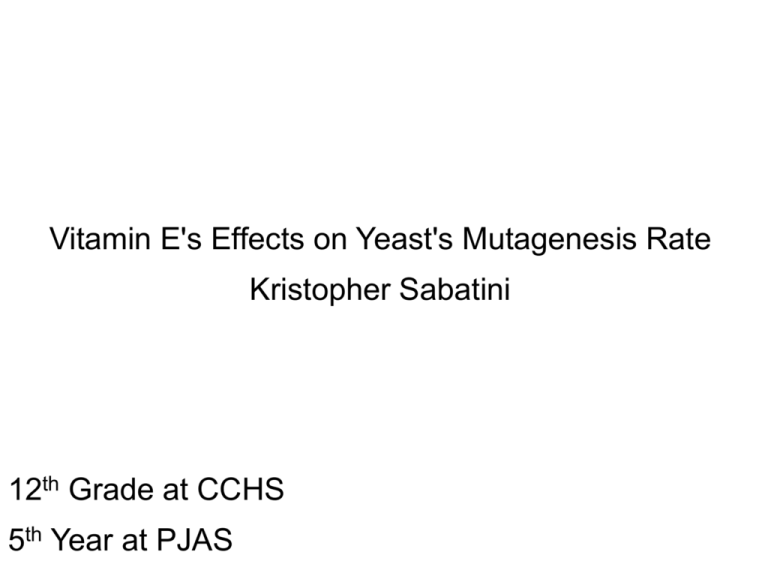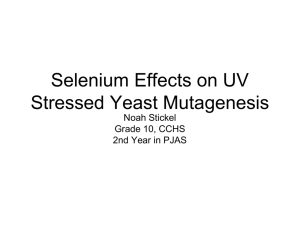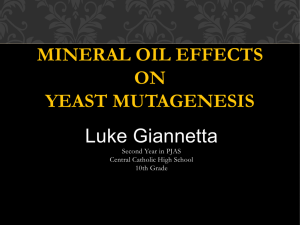vit E effects on yest mutagenesis Sabatini
advertisement

Vitamin E's Effects on Yeast's Mutagenesis Rate Kristopher Sabatini 12th Grade at CCHS 5th Year at PJAS Previous Studies ● ● ● ● ● Mixed and contradictory studies Positive anticancer effects on bladder and breast cancer No effect on kidney, lung nor cardiac cancer Linked to increase in prostate cancer in high doses Overall – beneficial to general health Vitamin E ● Common Anti-oxidant ● Found in nut oils and green vegetables ● Lipid Soluble and hydrophobic ● Variety of Isomers ● Alpha and gamma tocopherols– most useful to humans Ultraviolet Rays Light waves that have shorter wavelengths, thus greater energy, than visible light • • They range from 400nm to 10nm Given off from the sun but most are absorbed by the ozone layer • • Mutagen – Direct DNA Damage Yeast • Commonly used model Tolerant and safe to culture • Has similar reproduction, metabolism, and chemistry as other more advanced eukaryotic cells • Saccharomyces cerevisiae • • Special Strain, unable to produce Lysine a - Ketoglutarate Lysine AcCoA CoA Homocirate Water Homoaconitate Lysine’s codons are AAA and AAG • There are defined minus lysine yeast mutants used in research. • NAD NADH CO2 Homoisocitrate HC Synthase LYS7 LYS4 Glutamate LYS12 a-Ketoglutrate a - Ketoadipate Lys 2 mutants are missing an enzyme function within the lysine biosynthesis pathway. • Result – cells require lysine supplementation • ATP PP NADPH NADP aAA- Aminotranfease a- Aminoadipate Glutamate NADPH NADP Water LYS2 a- Aminodipate Semialdehye NADP; NADP a- Ketoglutarate Lysine LYS9 Saccharopina LYS1 Ames Test Developed to test the mutagenic and anti-mutagenic properties of various chemicals by Bruce Ames in 1970s. - Ames used a minus histidine mutant Salmonella (single point substitution). Bacteria cannot synthesize histidine due to this mutation. - Exposure to suspected mutagen correlated with increased reversion (mutation) rate. - Visible colonies appearing on complete (-His) media evidence of mutation through reversion - Obviously, a lower limit on mutation rate, because only 1 DNA site in genome assayed. - Modified Ames Test (-) Lys Yeast – Eukaryote • The number of reverted colonies of yeast can be correlated with the rate of mutation. • A reversion at that point can result in a reversion back to wild type yeast (lys +). • Mutagen substitution – UV light instead of heat • Objective ● To determine what effects Vitamin E has on Yeast's Mutagenesis Rate Hypothesis ● Vitamin E will not have an effect on Yeast's Mutagenesis Rate Materials 45 (-) Lysine YEPD agar plates(1% yeast extract, 2% peptone, 2% dextrose, 1.5% agar) •UV Light Oven (LD-50 on Yeast is 30 seconds) •Sterile dilution fluid [SDF] (10mM KH2PO4, 10mM K2HPO4, 1mM MgSO4, .1mM CaCl2, 100mM NaCl) •Klett spectrophotometer •Sterile pipette tips and Micropipettes •Vortex • Sidearm flask •Spreader bar •Ethanol • Micro burner • (-) Lysine Saccharomyces cerevisiae (John Wolford lab, CMU) •Rubber Gloves • Test tubes •Microtubes • Test Tube Rack • SDF Test Tubes • Vitamin E Oil Solution • Procedure 1. A strain of yeast (-) Lys phenotype was grown for 2 days in YEPD media. 2. 1 day prior to experimentation the media was removed from the cell pellet and replaced with 3 mL of SDF. 3. The Vitamin was sterile filtered 4. The stock solution was sterilized with a 0.22 syringe micron-filter. 5. The pellet in SDF was resuspended. 6. The following ingredients were pipetted into sterile mircotubes. (Percents are by volume compared to stock solution) Water Variable Yeast Volume Tubes 1 and 2 0. 8 mL 0 mL 0.2 mL 1 mL Tubes 3 and 4 0.79 mL 0.01 mL 0.2 mL 1 mL Tubes 5 and 6 0. 7 mL 0.1 mL 0.2 mL 1 mL Two Tubes per concentration were used as 1.5 mL were needed 7. The cells were allowed to sit for 15 min. 8. 0.1 mL aliquots were spread onto 45 complete (-) Lys (15 each) agar plates (necessary to show cells that have reverted through mutation to wild type + lys ). 9. The plates were exposed to UV light for either 0, 15, 30 seconds 10. The plates were allowed to incubate for 3 days at 32o C. 11. The colonies were counted and recorded. Each colony assumed to have arisen from 1 cell. Results Vitamin E's Effects on Yeast's Mutagenesis Rate 45 40 35 30 0.00% 1.00% 10.00% 25 Colonies 20 15 10 5 0 0s 15s Exposure Time 30s ANOVA Statistical Analysis Alpha Value = 0.05 Test P-Value Interpretation Two Factor ANOVA 0.0000239948038879 Significant 2 Single Factor ANOVA 1.49668808058975E Insignificant on isolated on UV -08 Single Factor ANOVA 0.806861423820598 Significant on isolated Vitamin E Dunnett's Test Test T-Value Interpretati on 0s 0% vs 0s 1% 1.46 Insignificant 0s 0% vs 0s 10% 1.65 Insignificant 15s 0% vs 15s 1% 8.36 Significant 15s 0% vs 15s 10% 11.98 Significant 30s 0% vs 30s 1% 6.78 Significant 30s 0% vs 30s 10% 6.56 Significant T- crit = 3.29 Conclusion ● ● ● ● ● The Null Hypothesis can be rejected in both the 1% and 10% groups The insignificant variance in the no exposure group fits expectations (no mutagen thus little mutation) In each of the two other exposure groups, the Vitamin yielded significant results when compared back to the control of that group The lower colony counts in the 30s groups is may be due to UV light outright killing the colonies This results can be contributed to Vitamin E's anti-oxidant abilities combating the free radicals formed by UV stress Limitations and Extensions ● Limitations ● ● ● Unsynced plating which leads to slightly different exposure times to Vitamin E Inability to control the exact amount of cells on each plate (minor difference overshadow by massive amount of cells) ● Slight positioning differences in UV Oven ● Inability to account for cell deaths due UV Light Extensions ● Different model ● Reduce lag time with lab hands ● Almar Blue Assay to account for cell deaths Sources http://www.uic.edu/classes/phar/phar332/Clinical_Cases/vitamin%20cases/vitamin%2 0E/Vitamin%20E%20Chemistry.htm http://users.rcn.com/jkimball.ma.ultranet/BiologyPages/A/AmesTest.html http://theoncologist.alphamedpress.org/content/6/3/298.full http://student.ccbcmd.edu/~gkaiser/biotutorials/protsyn/mutate.html http://jama.ama-assn.org/content/306/14/1549 http://ods.od.nih.gov/factsheets/vitamine/ http://www.huffingtonpost.com/craig-cooper/vitamine-e-prostate-cancer_b_1016922.html








